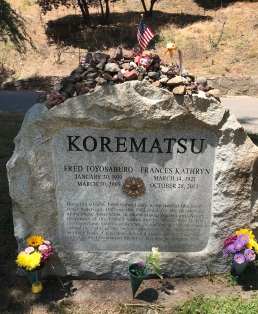Part One
July 4th 2019: A Salvadoran father and his young daughter drowned in the Rio Grande River. Families separated. Concentration camps. Children subjected to inhuman conditions amounting to torture while their parents are deported. Mothers told to drink from toilets. Border Patrol agents posting racist and misogynist cartoons on Facebook. Every day now we hear heartbreaking news from the borderlands. How, we wonder, can our government treat people with such gratuitous cruelty, has it ever been this bad?
While Trump and his stormtroopers churn up the National Mall and the streets of Washington with military hardware, I take a break from writing and go for a walk in Oakland’s Mountain View Cemetery. A series of chance turns takes me to the grave of Fred Korematsu, the Japanese-American who was convicted for evading internment during World War Two. Concentration camps.
This is an appropriate moment for us all to pause and consider how the nation has determined exactly who is privileged to live within the pale of “us” – the good, the true, the exceptional, the innocent – and who is not.
As I write in “The Myth of Immigration”:
…the immigrant plays a curiously ambiguous role in the narrative of American innocence. Immigrants are outsiders who in aspiring (or threatening) to be in transition to becoming insiders, force insiders to question something we quite ambiguously refer to as the American Dream. To the Paranoid Imagination, however, they threaten to pollute that dream.
A further ambiguity is that their condition is qualified by their skin color. The story of American immigration announces a welcome to all that is enshrined on the Statue of Liberty: “Give me your tired, your poor, your huddled masses yearning to breathe free…” There may be no poetic line better known in the entire world. But this story – the Melting Pot, or the Ellis Island myth – is rife with such contradictions that its adherents have required an entire mythology to resolve them, a massive, ongoing, national, cognitive dissonance. When facts meet myth, it is the truth that must change to fit the myth.
One could also argue for the simple statement that American immigration has always been about those whites who were welcomed and those others, including the conditionally white, who were tolerated.
So here is a detailed timeline of how America has negotiated that fine line – the border – between “us” and “them.” It’s a long and exhausting list, but I suggest that it falls into the “Don’t look away!” category. Yes, it has been this bad before, and no, we cannot become who we were meant to be without fully acknowledging who we are.
1600-1800: Over half of all immigrants to the British colonies arrive as indentured servants or slaves.
1610: The English massacre between 16 and 65 Paspahegh Indians near Jamestown.
1623: English settlers poison the wine at a “peace conference” with Powhatan leaders, killing 250.
1636: Connecticut Puritans massacre 500 Pequot people at the Mystic River.
1675: Rhode Island militia attack a Narragansett fort, killing at least 350.
1689: The Spanish destroy the Pueblo of Zia, New Mexico, killing 600.
1704: English colonists attack Apalachee villages in Florida, killing 1,000.
1705: Several states including New York pass laws designed to prevent runaways from fleeing to Canada.
1712: French troops kill 1,000 Fox Indians on the Detroit River.
1774: The Continental Congress leaves it to each state to decide who shall be a voting citizen.
1780: Thomas Jefferson writes, “…if we are to wage a campaign against these Indians, the end proposed should be their extermination, or their removal beyond the lakes of the Illinois River.”
1782: The motto E Pluribus Unum (Out of many, one) appears on the Great Seal of the United States.
1776: The new government grants full citizenship and voting rights to white male property owners (about 6% of the population), with six states granting it to all white males whether they own property or not. Some states require membership in a specified religion.
1789: Congress places the Secretary of War in charge of Indian affairs.
1790-1800: Nearly 100,000 immigrants enter the country, perhaps 20,000 of them as Catholic refugees fleeing political repression in France, Santo Domingo (Haiti) and Ireland.
1790: All foreign “free white persons” are naturalized, and only two years residency required before one can become a citizen. Freed male slaves can vote in four states. Women carry the legal status of their husbands. Property-owning women can vote in New Jersey only.
1792–1856: Various states abolish property qualifications for white men but retain them for blacks. Tax-paying qualifications remain in five states until 1860 and survive in Pennsylvania and Rhode Island until the 20th century. Free black males lose the right to vote in several Northern states.
1793: The first Fugitive Slave Act authorizes local governments to seize and return escaped slaves to their owners and impose penalties on anyone who aids in their flight.
1795: Congress extends the residency requirement to five years. The government encourages Indians to embrace mainstream white American customs so they can assimilate into American society. The Cherokee, Muscogee, Seminole, Chickasaw and Choctaw tribes do so, becoming known as the “five civilized tribes.”
1798: “Nativists” pass the four Alien and Sedition Acts. Congress raises the residency requirement to 14 years. All immigrants must register with the government within 48 hours of arrival, and all aliens who are citizens or subjects of a nation with which the U.S. is at war are forbidden from becoming American citizens. Only ten years after freedom of speech becomes part of the Constitution, the Sedition Act restricts speech that is critical of the federal government and results in the prosecution of many newspaper owners.
1800-1801: The Sedition Act and the Alien Friends Act are allowed to expire. But the Alien Enemies Act remains in effect. It will be revised and codified in 1918 and remains in effect today.
1802-1803: Thomas Jefferson signs the Georgia Compact, an agreement to buy all Indian land in Georgia as soon as possible. The Louisiana Purchase provides western land for Indian resettlement. All federal administrations thereafter encourage Indians to emigrate west.
1807: New Jersey dis-enfranchises women.
1812-21: Six “western” states join the union with full white male suffrage. Maryland excludes Jewish Americans from state office until the law requiring candidates to affirm a belief in an afterlife is repealed in 1828.
1813: Tennessee troops attack an unsuspecting Creek town, killing 200.
1817: The Cherokee Nation makes its first land exchange, accepting a western tract in present-day Arkansas for one in present-day Georgia. But Most Cherokees refuse to emigrate.
1824: The Office (later, Bureau) of Indian Affairs is formed.
1829: Irish immigrants riot against free blacks in Cincinnati. Thousands of blacks leave for Canada.
1830-1839: The Indian Removal Act calls for relocation of all Native Americans west of the Mississippi River. 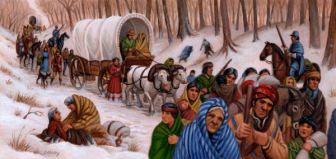 The Cherokees contest it. The Supreme Court decides in their favor, but Andrew Jackson ignores it. The Army forces tens of thousands of the civilized tribes and other indigenous peoples into concentration camps (called “emigration depots”) and then onto what becomes known as The Trail of Tears. Several thousand die on the journeys.
The Cherokees contest it. The Supreme Court decides in their favor, but Andrew Jackson ignores it. The Army forces tens of thousands of the civilized tribes and other indigenous peoples into concentration camps (called “emigration depots”) and then onto what becomes known as The Trail of Tears. Several thousand die on the journeys.
1831: Nat Turner’s slave rebellion in Virginia.
1834: “Know-nothing” nativists burn a convent in Boston.
1844: Nativists riot in Philadelphia.
1846-1860: A million and a half Catholic Irish arrive, 50,000 of whom (including many U.S. citizens) are deported back to Ireland. Thousands are drafted into the army, but when the U.S. invades Mexico, several hundred Irish revolt, join the Mexican army and form the “Saint Patrick Battalion.”
1849-1869: White Californians deliberately murder 9,000-16,000 Native Americans.
1850: The Second Fugitive Slave Act adds more provisions regarding runaways and levies even harsher punishments for interfering in their capture. In some cases, it enables enslavement of free Blacks.
1853-56: The U.S. acquires 174 million acres of Indian lands through 52 treaties, every one of which it will subsequently break. 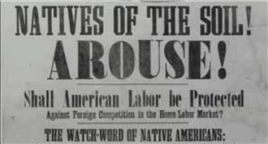 Forty-three Congressional representatives are members of the nativist American Party, known also as the Know-Nothing party. With its single platform that resists Catholic, especially Irish, immigration, it is the first example of many in U.S. history when large numbers of citizens are intolerant of other white people.
Forty-three Congressional representatives are members of the nativist American Party, known also as the Know-Nothing party. With its single platform that resists Catholic, especially Irish, immigration, it is the first example of many in U.S. history when large numbers of citizens are intolerant of other white people.
1856: North Carolina is the final state to abolish the property requirement for voting. Previously barred Catholics and non-Christians are enfranchised. Some states allow white immigrants not yet naturalized to vote.
1857: In the Dred Scott case, the Supreme Court decides that no black person can be a U.S. citizen. Oregon is admitted as a state with a law (not abolished until 1927) that excludes all Blacks from settling there.
1859: Settlers massacre 70 Achomawi Indians on Pit River in California.
1860: One in seven Caucasians is foreign-born.
1862: Minnesota governor Alexander Ramsey calls for ethnic cleansing, offering a bounty of $200 for the scalp of each fleeing or resisting Indian. Around 1,700 Dakota are force-marched into a concentration camp. The Lincoln administration hangs 38 after an uprising. The first Homestead Act opens up millions of acres for settlement.
1863: New York City Draft riots, Irish against blacks. The Union Army presses newly-freed slaves throughout the South into “contraband camps.”
1864: The army, under Kit Carson, forces 10,000 Navajo people to march 300 miles in winter from their homeland in the Four Corners region to a concentration camp at Fort Sumner, New Mexico. some 1,500 die while interned there. The Colorado militia attacks a peaceful village of Cheyenne, killing up to 163 at Sand Creek.
1865: The Enrollment Act penalizes draft evasion or desertion with denationalization (loss of citizenship).
1866-1868: Following the end of the Civil War, the first Civil Rights Act declares all persons born in the U.S. (except Indians) to be natural citizens. This legal protection is ratified under the 14th Amendment to the Constitution. For the first time, some people other than whites are considered to be citizens. The second Homestead Act explicitly encourages black Americans to participate, but rampant discrimination, systemic barriers and bureaucratic inertia slow black gains. Further Homesteading laws will be passed into the 1930s.
1868: George Custer’s 7th Cavalry attacks a Cheyenne village, killing 200.
1869: The Territory of Wyoming is the first to grant women suffrage in state elections.
1870: The 15th Amendment enfranchises Blacks. The South responds with Black Codes, poll taxes, literacy tests, grandfather clauses, convict leasing and terrorism. Naturalization of black immigrants (but not Asians or Mexicans) is permitted. The 1870s will see 16 major race riots.
1871: Residents of the District of Columbia lose the right to vote for mayor and city council. Western Indians are forbidden to leave reservations without permission.
1874: Nearly a century after the Declaration of Independence, the Supreme Court rules that it is not unconstitutional to deny women the right to vote.
Part Two
1875: The Oriental Exclusion Act bars entry of Chinese, Japanese, prostitutes, felons, and contract laborers, to “end the danger of cheap Chinese labor and immoral Chinese women.” It effectively bars all Asian women, “…few of whom,” says President Grant, “are brought to our shores to pursue honorable or useful occupations.” The American Medical Association argues that Chinese immigrants “carried distinct germs to which they were immune, but from which whites would die if exposed.”
1876: Following the end of Reconstruction, thousands of municipalities (known as “Sundown Towns”) begin to establish restrictions that exclude non-whites, and in some cases, Jews, after sunset, on penalty of death.
1878-1930: Over 4,000 people, overwhelmingly African-American, will be lynched. During this same period, military and police forces (including the Texas Rangers) and vigilantes murder between several hundred and 5,000 Mexican-Americans along the borderlands.
1879: The Carlisle Indian Industrial School becomes a model for others to be established by the Bureau of Indian Affairs (BIA). 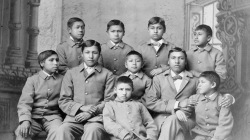 It utilizes forced assimilation to Christian culture and abandonment of Native American traditions.
It utilizes forced assimilation to Christian culture and abandonment of Native American traditions.
1882: The Chinese Exclusion Law suspends immigration of laborers for ten years. 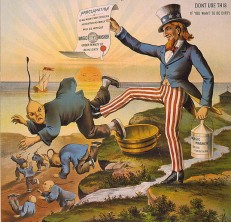 It prohibits “any convict, lunatic, idiot, or any person unable to take care of himself or herself without becoming a public charge” from entering the country. Prior to this date, nearly anyone except for the Chinese and Japanese who crossed the borders had been considered legal. The term “illegal immigrant” is first used. It is possibly the first time in recorded history that a country denies entrance to people based exclusively on their skin color or country of origin. The 1880s will see seven major white-on-black race riots.
It prohibits “any convict, lunatic, idiot, or any person unable to take care of himself or herself without becoming a public charge” from entering the country. Prior to this date, nearly anyone except for the Chinese and Japanese who crossed the borders had been considered legal. The term “illegal immigrant” is first used. It is possibly the first time in recorded history that a country denies entrance to people based exclusively on their skin color or country of origin. The 1880s will see seven major white-on-black race riots.
1885: The Alien Contract Labor Law prohibits the importation of foreigners to perform labor, including “professional actors, artists, lecturers, or singers (and) persons employed as strictly personal or domestic servants.”
1887: The Dawes Act grants citizenship to Native Americans who are willing to disassociate themselves from their tribe. Utah is the second territory to allow women to vote, but the federal Edmunds–Tucker Act repeals woman’s suffrage there.
1888: The Supreme Court affirms (and will repeatedly re-affirm) that corporations have all the rights of people.
1889: Oklahoma’s first “land rush” occurs as the federal government opens nearly two million acres to settlement. Additional land rushes will occur in 1891 (twice), 1893 and 1895.
1890: The government assumes control of immigration and constructs the Ellis Island Inspection Station.  It will eventually process 12 million immigrants, who will become the ancestors of 100 million Americans. The Bureau of Immigration is created to enforce federal immigration laws, especially the ban on Asians. All reservations in Indian Territory are annexed into the new Oklahoma Territory. The 7th Cavalry attacks and kills 130-250 Sioux at Wounded Knee, South Dakota. The 1890s will see nine major race riots.
It will eventually process 12 million immigrants, who will become the ancestors of 100 million Americans. The Bureau of Immigration is created to enforce federal immigration laws, especially the ban on Asians. All reservations in Indian Territory are annexed into the new Oklahoma Territory. The 7th Cavalry attacks and kills 130-250 Sioux at Wounded Knee, South Dakota. The 1890s will see nine major race riots.
1891: A New Orleans mob lynches a group of eleven Italian-Americans. The government issues a compulsory attendance law enabling federal officers to forcibly take Native American children from their homes and reservations. In Oklahoma territory a land lottery is held instead of another land rush.
1892: The Geary Act requires all Chinese to carry resident permits on penalty of deportation and prohibits them from testifying in court.
1896: The Plessy vs Ferguson decision (“Separate but equal”) legalizes segregation.
1898: The Supreme Court rules that a child born in the U.S. of parents of Chinese nationality is a citizen. The Curtis Act amends the Dawes Act. It results in the break-up of tribal governments and communal lands in Oklahoma. The Five Civilized Tribes who had suffered the Trail of Tears had previously been exempt because of the terms of their treaties. They lose control of over 90 million acres.
1899: The Oklahoma Territorial Legislature prohibits the practices and healing ceremonies of native medicine men, who are subject to fines or imprisonment.
1901: A series of Supreme Court decisions known as the “Insular Acts” determines that full citizenship rights do not extend to all places under American control, especially islands where people of color live (“savage” and “alien races”) who cannot understand “Anglo-Saxon principles.” This permanently excludes Puerto Ricans, Samoans and many others from voting for President. The decade will see eleven large race riots.
1902: The government funds 25 non-reservation schools in 15 states and territories, enrolling over 6,000 students. Anti-Semitic riots occur in New York City.
1902-1904: Chinese exclusion is extended and then made indefinite.
1903: The Immigration Act of 1903 is also called the Anarchist Exclusion Act.
1905: The Cherokee, Creek, Seminole and Choctaw nations 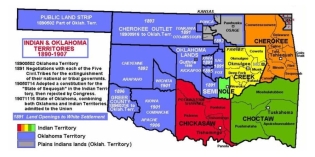 create a constitution for a proposed state of Sequoyah, which would be distinct from Oklahoma. Congress ignores them.
create a constitution for a proposed state of Sequoyah, which would be distinct from Oklahoma. Congress ignores them.
1906: Theodore Roosevelt declares in his State of the Union Message, “The greatest existing cause of lynching is the perpetration, especially by black men, of the hideous crime of rape – the most abominable in all the category of crimes, even worse than murder.” The Burke Act amends the Dawes Act, dissolving sovereign tribal governments and communal lands. It requires the government to assess whether individuals are “competent and capable” before granting them their allotted land. Citizenship is not to be granted to Native Americans until the end of a 25-year probationary period. White mobs kill between 25 and 100 blacks in Atlanta.
1907: Oklahoma becomes a state. Congress again lowers the threshold for exclusions to include “All idiots, imbeciles, feebleminded persons, epileptics, insane persons, and persons who have been insane within five years previous; persons who have had two or more attacks of insanity at any time previously; paupers; persons likely to become a public charge; professional beggars; persons afflicted with tuberculosis or with a loathsome or dangerous contagious disease…”The Expatriation Act decrees that any naturalized citizen residing for two years in one’s foreign state of origin or five years in any other foreign state or any American woman who marries an alien loses their citizenship.
1909: Nativists destroy a Greek immigrant community in South Omaha, Nebraska.
1910: The Angel Island Immigration Station begins operation in San Francisco Bay 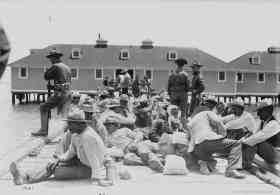 to monitor the flow of Chinese entering the country. It will eventually hold hundreds of thousands. By 1915, Japanese immigrants will outnumber Chinese. At Ellis, only 1-3% of all arriving immigrants will be rejected, while at Angel, due to anti-Asian discrimination, the number will be about 18%. While Ellis arrivals enter the country almost immediately, Asians are frequently imprisoned on Angel for many months. Nationwide riots follow the heavyweight championship victory of Jack Johnson. Whites kill dozens of blacks in Slocum, Texas.
to monitor the flow of Chinese entering the country. It will eventually hold hundreds of thousands. By 1915, Japanese immigrants will outnumber Chinese. At Ellis, only 1-3% of all arriving immigrants will be rejected, while at Angel, due to anti-Asian discrimination, the number will be about 18%. While Ellis arrivals enter the country almost immediately, Asians are frequently imprisoned on Angel for many months. Nationwide riots follow the heavyweight championship victory of Jack Johnson. Whites kill dozens of blacks in Slocum, Texas.
1913: The 17th Amendment gives voters rather than state legislatures the right to elect senators.
1917: Congress requires that immigrants pass a literacy test. It bars immigration from the Asia-Pacific Zone and creates new categories of inadmissible persons, including: “alcoholics,” “anarchists,” “contract laborers,” “criminals and convicts,” “epileptics,” “feebleminded persons,” “idiots,” “illiterates,” “imbeciles,” “insane persons,” “paupers,” “persons afflicted with contagious disease,” “persons being mentally or physically defective,” “persons with constitutional psychopathic inferiority,” “political radicals,” “polygamists,” “prostitutes” and “vagrants.”
1917: White rioters kill 100-200 black residents of East St. Louis.
1918: Servicemen of Asian ancestry who served in World War I receive the right of naturalization.
1919: American Indian soldiers and sailors receive citizenship. The Palmer raids during the Red Scare result in the deportation of 500 non-citizens. Twenty-five white-on-black urban race riots occur during the summer.
1920: The 20th Amendment gives women the right to vote.
1921: The Emergency Quota Act establishes numerical limits and quotas “to preserve the ideal of American homogeneity.” It prohibits the immigration of Arabs, East Asians and Indians, and it restricts the number of immigrants admitted from any country annually to 3% of the residents from that country living in the U.S. in 1910. So people from northern Europe have a higher quota than people from eastern or southern Europe or non-European countries. The number of new immigrants admitted falls from 800,000 in 1920 to 300,00 in 1921-22. 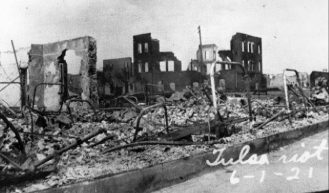 In the worst incident of racial violence in American history, white mobs attack blacks in Tulsa, Oklahoma. They destroy more than 35 square blocks and kill 100-300 blacks.
In the worst incident of racial violence in American history, white mobs attack blacks in Tulsa, Oklahoma. They destroy more than 35 square blocks and kill 100-300 blacks.
1922: Congress partially reverses former immigration laws regarding marriage and allows women to retain their US citizenship after marrying a (non-Asian) alien if she stays within the United States.
1923: White mobs destroy the black town of Rosewood, Florida, killing up to 150.
1924: Native Americans receive the right to vote. Congress establishes the Border patrol on the Mexico border. The National Origins Act further restricts immigration from Eastern and Southern Europe and requires for the first time that immigrants have visas. It introduces the concept of “having papers” to immigration policy. Almost none of those who immigrated “legally” prior to this point would be admitted under these far more stringent standards. It establishes deportation courts for non-white immigrants and Eastern and Southern European immigrants who exceed their national quotas. Subsequent court rulings will determine that Asian Indians are not white and cannot immigrate. The act puts an end to a period where the United States essentially had open borders.
Since persons of mixed white and Native American ancestry are considered white, the law continues to allow Latin Americans to immigrate as “white persons” in unlimited numbers, despite being ineligible for citizenship. While it spares Mexico a quota, secondary laws, including one that makes it a crime to enter the country outside official ports of entry, give border and customs agents on-the-spot discretion to decide who can enter legally. This turns what had been a routine daily or seasonal event — crossing the border to go to work — into a ritual of abuse. Degrading hygienic inspections, literacy tests and entrance fees are introduced.
1925-1936: Nearly two million Mexicans are deported, most without due process. Sixty percent are U.S. citizens, most of whom have never been to Mexico. The Ku Klux Klan grows to 4-5 million members, including thousands of Protestant ministers.
1929: The Registry Act allows aliens to register as permanent residents if they can prove they have lived in the U.S. since 1921 and are of “good moral character.” Between 1925 and 1965, 200,000 illegal Europeans will use this law to legalize their status.
1929-1933: During the Depression, more people emigrate from the United States than to it.
1931: Congress allows females to retain their citizenship even if they marry an Asian.
1930s: Until this decade, most legal immigrants have been male.
1936-1945: The U.S. refuses to admit most Jewish refugees of the Nazis.
1940: Angel Island closes.
Part Three
1941: Utilizing secret date provided from the 1940 census, Franklin Roosevelt establishes Executive Order 9066. It forces 110,000 Japanese-Americans – as well as 2,200 Latin Americans of Japanese descent, mostly residents of Peru – into concentration camps. 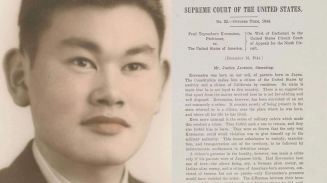 Fred Korematsu challenges the policy before the Supreme Court, which decides that compulsory exclusion is justified. German-Americans are not affected, nor are Japanese-Americans in Hawaii, who are deemed necessary to the war effort.
Fred Korematsu challenges the policy before the Supreme Court, which decides that compulsory exclusion is justified. German-Americans are not affected, nor are Japanese-Americans in Hawaii, who are deemed necessary to the war effort.
1942: Addressing a severe shortage of farm workers, the government establishes the Bracero Program, which ultimately imports over four million temporary agricultural laborers from Mexico. However, by excluding women, it guarantees that women and children have no access to legal routes of migration and can only follow their men illegally. The result is a bifurcated labor system; one is legal and male, and the other is unlawful, female and full of children.
1943: Congress repeals the Chinese Exclusion Act, but it limits Chinese immigration to 105 persons per year. 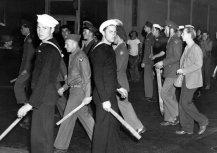 Race riots occur in over a dozen cities. Thousands of white servicemen rampage for a week through East Los Angeles, attacking Latinos in the “Zoot Suit Riots.” Police arrest only Latinos.
Race riots occur in over a dozen cities. Thousands of white servicemen rampage for a week through East Los Angeles, attacking Latinos in the “Zoot Suit Riots.” Police arrest only Latinos.
1945: The War Brides Act permits immigration of Asian spouses and children of American servicemen. Among the 100,000 persons admitted are 1,500 German scientists and spies, including many Nazis.
1946: Congress grants naturalization rights and small immigration quotas to Asian Indians and Filipinos. After the war, half of the Japanese Latin Americans who had been held in the camps are deported to Japan when their home countries refuse to take them back.
1948: The Displaced Persons Act allows for up to 200,000 European refugees who have reached certain safe zones by certain dates to be admitted to the U.S. It deliberately discriminates against some 250,000 Jews who have not yet reached those zones by Dec 22, 1945.
1948-1960: HUAC engages in a reign of terror that demonizes much political activity and speech as “un-American.” The FBI investigates thousands of citizens, resulting in hundreds fired from government and academia, many suicides and the Hollywood blacklist.
1949: After the Chinese Revolution, 5,000 educated, anti-Communist Chinese receive refugee status.
1950: The Internal Security Act bars members of communist or fascist organizations. By then, the former Nazis scientists have been admitted and naturalized. Amendments to the 1948 law extend the total allotment of visas for displaced persons to 400,000, including 80,000 Jews. The McCarran Act requires Communist organizations to register with the government and have their literature stamped as propaganda. It bans Communists from holding passports or government jobs and establishes a control board to investigate persons suspected of joining such groups, members of which cannot become citizens. Immigrants found in violation of the act can have their citizenship revoked. Six concentration camps are built to hold communists, peace activists and others deemed a threat if the government declares a state of emergency.
1950-1980: At least 14 predominantly African-American churches will be bombed or burnt down across the South.
1952: The Immigration and Nationality Act abolishes all racial restrictions. Japanese Americans and Korean Americans are allowed to naturalize. However, these countries receive only small, token quotas of about 100 people per year. The law defines three types of immigrants: those with special skills or relatives of U.S. citizens who are exempt from quotas; average immigrants; and refugees. It again bars suspected subversives, including former members of the Communist Party, even those who had not been associated with the party for decades.
1953: The Refugee Relief Act admits more persons from Southern Europe, including 60,000 Italians, 17,000 Greeks and 45,000 from communist countries. Applicants undergo a thorough security screening and must show a guaranteed home and job. President Eisenhower issues Executive Order 10450, under which 5,000 federal employees are fired as suspected homosexuals.
1954: Ellis Island closes. With most former white farmers having returned from war, Operation Wetback deports over 250,000 Mexicans. The Border Patrol changes its language from “policing unsanctioned laborers” to “policing criminal aliens.”
1957: Utah becomes the last state to permit Native Americans to vote.
1961: Residents of Washington, D.C. receive the right to vote in presidential elections. The 1960s will see 160 riots.
1965: The Voting Rights Act enfranchises racial minorities and prohibits poll taxes. The Immigration and Nationality Act abolishes “national origins” as the basis for allocating immigration quotas, thus opening the doors to immigrants from Asia, Africa, and the Middle East. It creates a seven-category preference system giving priority to relatives of U.S. citizens, legal permanent residents and professionals and other individuals with specialized skills, but for the first time it limits immigration from Mexico to 20,000/year. This results in the beginning of large-scale illegal immigration. The INS continues to deny entry to homosexuals on the grounds that they are “mentally defective” or have a “constitutional psychopathic inferiority.” Blacks riot in Watts (Los Angeles).
1966: The Supreme Court prohibits tax payment and wealth requirements for voting in state elections. The Cuban Adjustment Act simplifies and expands possibilities for Cuban immigration, without mentioning any other Latin American country.
1967: The Bracero Program ends. 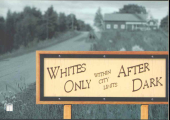 Thousands of “Sundown Towns” still exist. There are sixteen major race riots.
Thousands of “Sundown Towns” still exist. There are sixteen major race riots.
1968: Martin Luther King, Jr. is assassinated; 125 riots follow across the country.
1969: President Richard Nixon launches Operation Intercept, requiring customs agents to search every vehicle entering the U.S. for drugs. It throws border crossings into chaos and ends after three weeks. The Stonewall riots in New York begin the modern fight for LGBT rights. HUAC becomes the House Committee on Internal Security.
1970: Congress passes the Equal Rights Amendment and sends it to the state legislatures with a seven-year deadline to acquire ratification.
1971: Adults aged 18 through 21 receive the right to vote. The 1970s will see 16 riots.
1973: Enrollment at Indian boarding schools reaches its highest point, 60,000. The Wounded Knee Incident occurs. Activists at the Pine Ridge Reservation occupy the land for over two months. A judge rules that sexual orientation alone cannot be the sole reason for termination from federal employment.
1974: Residents of the District of Columbia regain the right to vote for mayor and city council but still lack voting representation in Congress.
1975: The Pine Ridge shootout occurs. The Indian Self-Determination and Education Assistance Act calls for decentralizing students from boarding schools to community schools. Many large schools will remain open until the early 1990s. The Civil Services Commission announces that it will consider applications by gay people on a case by case basis. Congress ends the House Committee on Internal Security.
1976: President Gerald Ford terminates Roosevelt’s Executive Order 9066 and apologizes for the internment of the Japanese Americans. It is revealed that the Indian Health Service had sterilized 3,400 Native American Indian women without their permission between 1973 and 1976. North Carolina alone had sterilized 7,600 people, 40% of whom were minorities, between 1929 and 1974. Over a third of Puerto Rican women had been sterilized since the 1930s. Twenty thousand had been sterilized in California.
1978: Jimmy Carter approves $4.3 million to build a fence on the U.S.-Mexico border. White supremacist groups establish camps and train hundreds of vigilantes. Federal authorities ignore these paramilitary groups accosting migrants in the desert and investigate the priests, nuns and others involved in the Sanctuary Movement. The militia camps will expand well into the 21st century.
1979: The ERA fails to receive enough support in the states before its deadline.
1980: Carter appoints a commission to investigate the internment of the Japanese Americans. It concludes that the decisions to incarcerate them occurred because of “race prejudice, war hysteria, and a failure of political leadership,” and that the military had lied to the Supreme Court.
1980-2000: Successive administrations will allow massive immigration of Cubans while turning back those seeking political refuge from El Salvador and Guatemala. Defining the Haitian boat people  (as opposed to Vietnamese boat people) as economic rather than political refugees allows the government to refuse asylum to thousands and immediately deport them, even as Cubans and Vietnamese find housing and jobs. Israelis are another special case, with unlimited immigrant privileges, unique in the Middle East.
(as opposed to Vietnamese boat people) as economic rather than political refugees allows the government to refuse asylum to thousands and immediately deport them, even as Cubans and Vietnamese find housing and jobs. Israelis are another special case, with unlimited immigrant privileges, unique in the Middle East.
1983: Corrections Corporation of America becomes the first for-profit prison company.
1985: Ronald Reagan attempts a partial border closure with Operation Intercept II. It ends quickly. The Philadelphia police use airplanes to drop bombs on black radicals, destroying an entire black neighborhood.
1986: Congress gives amnesty to 3 million undocumented immigrants already in the country and makes it illegal to knowingly hire or recruit illegal immigrants. Thousands of businesses and individuals will ignore the new law.
1988: The Civil Liberties Act pays $20,000 each in reparation to tens of thousands of Japanese-American survivors of the internment camps. The government, however, refuses to pay Japanese-Latin Americans, who then file suit.
1990: Congress revises all grounds for exclusion, including homosexuality, and ends the 1906 English language requirements. It increases total immigration to 700,000/year for 1992–94, and 675,000/year after that. It provides family- and employment-based visas and a lottery for immigrants from “low admittance” countries. In also creating temporary protected status for those unable to return home because of ongoing armed conflicts or environmental disasters, it specifically benefits El Salvadorans. The Border Patrol begins to erect physical barriers in its San Diego sector, ultimately erecting fourteen miles of fencing. The numbers of female legal immigrants reach parity with numbers of males. Lake Forest, Illinois ends its anti-Jewish and anti-African-American housing covenants.
1991 to 2000: The U.S. admits more legal immigrants, (ten to eleven million), than in any previous decade.
1990-2019: At least 48 predominantly African-American churches will be bombed or burned across the South.
1993: Bill Clinton begins Operation Hold the Line and Operation Gatekeeper, which focus on intercepting illegal entries at the border itself. Then, with the “Prevention Through Deterrence” strategy, the Border Patrol attempts to control immigrant movement by rerouting it away from urban ports of entry and into wilderness areas, thus heightening the risks. These programs cause at least 7,000 deaths and countless disappearances without halting the mass movement of people.
1993-2017: Joe Arpaio, Sheriff of Arizona’s Maricopa County, oversees what the Justice Department will call the worst pattern of racial profiling in U.S. history, including the re-introduction of chain gangs, until he is convicted and removed.
1994: Congress passes the North American Trade Agreement, which floods the Mexican rural economy with subsidized U.S. corn, undermines government protections for poor farmers and forces two million Mexican farmers off the land. The result is a massive increase in migration northward of formerly independent farmers.
1995: Clinton institutes the “wet foot, dry foot policy.” For the next two decades, any Cuban caught on the waters between the two nations (with “wet feet”) is summarily returned to Cuba, while one who makes it to shore (“dry feet”) gets a chance to remain in the U.S. and qualify for expedited “legal permanent resident” status.
1996: Clinton authorizes mandatory detention of illegal immigrants. Every illegal alien convicted of a serious felony is to be placed in expedited removal proceedings. He also authorizes construction of a secondary layer of border fencing to support the already completed 14-mile primary fence. Construction stalls because of environmental concerns. The number of immigrants in detention increases dramatically.
1998: The Japanese-Latin Americans who had sued for reparations ten years before win their lawsuit and receive $5,000 each.
2001: The DREAM (Development, Relief, and Education for Alien Minors) Act, which would grant residency status to qualifying foreign immigrants who entered the United States as minors, is first introduced in Congress. It will be debated for the next eleven years.
2002: The G.W. Bush administration creates the Department of Homeland Security. By 2017 it will have over 240,000 employees, a $40 billion budget and persistent allegations of waste, brutality and fraud.
2003: Bush creates the Immigration and Customs Enforcement agency (ICE). It will eventually have 20,000 employees and a $7.6 billion budget. It will detain about 34,000 people on any given day, in over 500 detention centers, jails, and prisons nationwide, and deport two million people.
2005: DHS’s national database of “critical terrorist targets” grows to 300,000 localities, including thousands of non-critical sites such as doughnut shops and petting zoos. Indiana will have more than California and New York combined.
2005: Operation Streamline initiates a “zero-tolerance” approach to unauthorized border-crossing by engaging in criminal prosecution of immigrants. Up to 70 people are tried at the same time, sometimes wearing shackles in the courtroom. The number of prosecutions will increase from 4,000 annually in the early 2000s to 16,000 in 2005, 44,000 in 2010 (under Barack Obama) and 97,000 by 2013. The Minuteman Project, a borderlands militia, claims nearly 1,000 members. The Real ID Act waives local laws that interfere with construction of physical barriers at the borders. Fred Korematsu dies.
2006: California officially apologizes for deporting Mexicans between 1925 and1931. State legislatures introduce over 1,400 immigration measures – a number that exceeds the total of the previous ten years. The Secure Fence Act authorizes construction of additional fencing, vehicle barriers, checkpoints, lighting, cameras, satellites and drones along the southern border.
2007: 9,500 Native American children are still living in Indian boarding schools.
2008: Congress estimates that DHS has wasted roughly $15 billion in failed contracts.
2009-2016: Obama deports 2.5 million immigrants, 40% of whom have no criminal conviction. Blacks riot in Baltimore, Oakland, Anaheim, Ferguson, Milwaukee and Charlotte following police shootings.
2010-2017: Immigrants file over 1,200 sexual abuse complaints against ICE agents, only 2% of which it investigates.
2011: DHS completes some 650 miles of border walls and fences. The government will later admit that illegal border-crossers had simply found new routes, that the fences had been breached thousands of times, and that the Secure Fence Act had caused at least 2000 additional deaths. California first observes “Fred Korematsu Day.”
2012: Obama announces that he will stop deporting undocumented immigrants who match certain criteria included in the proposed DREAM Act. He initiates the Deferred Action for Childhood Arrivals (DACA) program, which will eventually register 750,000 young people who entered the country as children, the vast majority of whom speak fluent English, have no connection to the countries of their birth, and have committed (by definition) zero crimes. Meanwhile, some 2,000-3,000 non-citizen veterans, promised that they would automatically become citizens through their service, face deportation.
2013: The Supreme Court strikes down the heart of the Voting Rights Act, claiming that racism is history, and effectively enabling many states to disenfranchise minorities once again.
2015: Obama successfully opposes full voting rights for Samoans, citing the 1901 Insular Acts. This prevents areas with four million Americans (almost all of them people of color) living in Puerto Rico, Guam, American Samoa and the Virgin Islands from voting for President and contributes to a Republican victory in the next election.
2016: Customs and Border Protection (CBP) grows to 62,000 employees, with a $14 billion budget. Bernie Sanders calls on Obama to end the deportation raids and instead extend temporary protected status to families who have fled violence in Central America.
2017: Obama cancels the “wet foot, dry foot policy” before leaving office.
2017-2019: Trump calls for building more walls, stopping all Muslim immigration (except for Saudi Arabia and other client states), removing citizenship for American-born children of non-citizens, adding a citizenship question to the 2020 census, ending DACA, imprisoning migrants in a camp that had held Japanese-Americans during World War Two, and sending the military to stop Central American migrant caravans. It is revealed that Melania Trump’s parents were the beneficiaries of “chain migration.” The Supreme Court rules that immigrants can be detained indefinitely. Trump pardons Joe Arpaio. The government separates thousands of immigrant children from their parents, even from those legally applying for asylum. Comprehensive Health Services pays a $3.8 million fine for double-charging the government for its services. It continues to charge $750 per detainee per day.
2018: The U.S. Citizenship and Immigration Services alters its mission statement by removing a reference to the U.S. as a “nation of immigrants.” The Justice Department instructs U.S. attorneys’ offices to replace the term “undocumented immigrant” with “illegal alien.” The Supreme Court lifts an injunction against enforcing the Muslim travel ban and confirms that the original Korematsu verdict was “gravely wrong…”
2019: For the fourth time, the government prosecutes a humanitarian volunteer, threatening a 20-year sentence for providing food and water to immigrants on the border. The trial ends in a hung jury, but the government appeals. Investigators reveal a DHS intelligence-gathering operation in the San Diego-Tijuana area targeting journalists, immigration attorneys, and advocates working with the migrant caravans. California officially apologizes for its genocide of Native Americans. The NAACP warns African Americans to carry bail money with them if they travel to Missouri. Florida re-enfranchises ex-felons and then essentially re-institutes the poll tax. A Justice Department lawyer argues before Congress against soap, toothbrushes or beds for detained children. The Border Patrol expressly orders agents to not hug them or even to allow siblings to hug each other.
Trump declares a national emergency, giving him the power to direct $6.1 billion more from other federal agencies for the wall (though over a dozen states challenge the executive order in court), bars all asylum seekers who pass through a third country and insults Congresswomen of color.
The government spends nearly $3.8 billion on grants and contracts initiated since Trump became president related to “unaccompanied alien children.” Immigration officials use secretive and unreliable gang databases to deny asylum claims and removes live interpreters from immigration courts. Homeland Security admits that its use of abhorrent conditions at detention centers is to deter immigrants from entering the country. Two Facebook groups that post hatred of immigrants have over 10,000 Border Patrol members, including the Chief of the Agency. The U.S. women’s soccer team sues for gender and pay discrimination. Defying Congress, ICE opens three new migrant jails.
Today: Legal immigrants are at their highest level ever, at just over 37,000,000. The U.S. has spent over $100 billion in border and immigration control since 9/11. 50,000 Irish reside in the country illegally without fear of deportation. Although all its constituent sections have long been repealed, Chapter 7 of Title 8 of the United States Code is still headed, “Exclusion of Chinese.”
I would like to see the government admit that they were wrong and do something about it so this will never happen again to any American citizen of any race, creed, or color…If anyone should do any pardoning, I should be the one pardoning the government for what they did to the Japanese-American people…One person can make a difference, even if it takes forty years. – Fred Korematsu
